"...and a Bag Full of Monkeys"
An exhibition from the University Museum Collections
at the Barrack Street Natural History Museum, Dundee
20 December 1997 - 11 April 1998
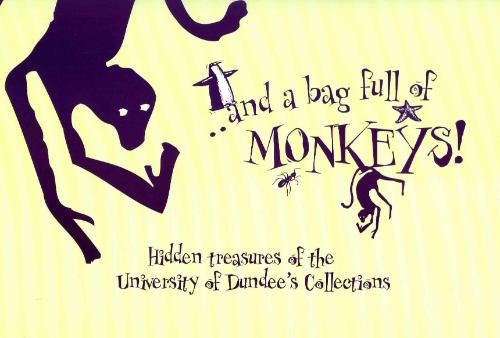
This is a reduced online version of the exhibition staged at the former Barrack Street Natural History Museum in Dundee. It looks at the work of Professor D'Arcy Thompson and the extraordinary zoology collection he created. Find out further information on the Zoology Museum.
Professor Sir D'Arcy Wentworth Thompson
"From a doorway strides an arresting figure - tall, bearded, crowned by a mighty grey hat - almost cowboy 10 gallon design - stick in hand, a parrot on his shoulder, here is Professor D'Arcy Thompson" - Professor Peacock, 1949

By far the most important person connected with the University Museum Collections was Professor D'Arcy Wentworth Thompson. He was a unique figure whose life spanned both world wars and the reign of five monarchs.
His wide range of knowledge and enormous energy enabled him to achieve many things during his 88 years of life. With his father being a Professor of Greek, he learned the love the classics at an early age, but decided to study sciences at University. He was noted for his teaching abilities and his continued encouragement of his graduates. He was also a very kind and friendly man much involved in his family life.
A statistician, biologist, mathematician, collector and teacher, he could read and write both French and German. His published works combined his skills in Latin and Greek with his knowledge of wildlife. Travelling the world many times over, he established contacts that allowed him to amass one of the finest zoological collections of its day.
"Summer and winter, my regent was never seen out of doors without his heavy nap coat. Originally black, it had turned green with age, with multicoloured streaks on the right shoulder where his parrot had left its signature" - Hamish Watt.
1860 - Born in Edinburgh 1878 - Attended Edinburgh University to study Medicine 1880 - Moved to Cambridge University 1883 - BA Degree from Cambridge in Natural Science 1884 - Appointed Professor of Biology at University College Dundee 1896 - First expedition to the Bering Straits 1901 - Marriage to Ada Maureen Drury, his stepmother's niece 1902 - Birth of first daughter Ruth 1908 - Birth of second daughter Molly 1910 - Birth of youngest daughter Barbara 1917 - Publication of On Growth and Form 1917 - Appointment to Chair of Natural History, St Andrews University 1937 - Awarded Knighthood 1948 - Died at home in St Andrews
D'Arcy Thompson - Teacher & Scientist
"When he speaks, I am willing to be silent" - W K Parker, Hunterian Professor, Royal College of Surgeons on D'Arcy aged 24
A memorable and imposing teacher, D'Arcy is remembered affectionately by all those whose lives he touched, however briefly. Even at the age of 24 when his references were written in support of his application for the Chair at Dundee, D'Arcy was recognised as having a great talent for teaching. He could talk to, and be understood by, people at all levels of education. He is frequently remembered for lecturing on an item he had just removed from his pocket. On the occasion of his last ever lecture, at the age of 87, he demonstrated his point by the use of a live chicken tucked under his arm!
In 1898, following the Bering Fur Seal Inquiry, he was appointed as Scientific Adviser to the Fisheries Board of Scotland. Later, he became a representative to the International Council for the Exploration of the Sea. He served on these boards for 41 years.
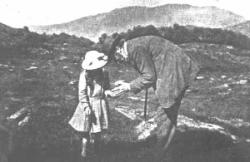
D'Arcy introducing his daughter
Barbara to a beetle
"I remember him as a large man, who would produce strippet balls from the bottom of the pockets of his great coat. And you would politely receive them even though they were covered in fluff" - Mrs Hathaway
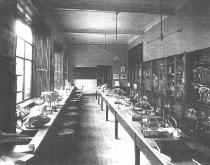
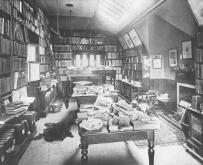
D'Arcy's teaching laboratory and study
D'Arcy - a great Victorian collector and naturalist
"Additions to my Museum are numerous. Within the last week I have had a porpoise, two mongooses, a small shark, an eel 8 ft long and 150 lb in weight, a young ostrich and two bagfuls of monkeys: all dead of course." - letter to his grandfather, 1885
When D'Arcy arrived in 1884, University College Dundee had just opened and he realised that as no museum existed he would have to create one. Without the visual images provided today, the best way to teach people about the natural world was to show them actual specimens.
Surviving on few funds he sought out specimens suitable to teach his biology classes. By purchase, personal collection and exchange he acquired specimens from around the globe. This prouced the zoology collection at the University which is particularly rich in skulls and bones.
D'Arcy and his contemporaries' attitude to collecting animals from the wild was one of great curiosity and a wish to show people at home the rich discoveries of explorers to new places in the world. This now irreplaceable collection needs to be preserved, so that we have the real specimen to look at without another one being collected from the wild.
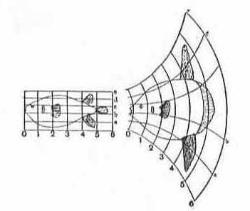
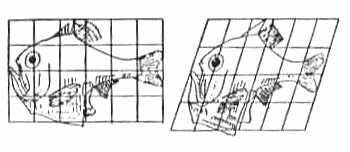
Diagrams from On Growth & Form
On Growth and Form
"Cell tissue, shell and bone, leaf and flower, are so many portions of matter, and it is obedience to the laws of physics that their particles have been moved, moulded and conformed."
D'Arcy's infinite curiosity led to a unique view of the natural world. By looking at the specimens in his collection as a mathematician, he viewed biology in a new light. He saw that the laws of physics, such as Gravity, could be applied to nature. He tested this new theory across a huge range of organisms, both living and extinct. The result of this work was summarized in his book On Growth and Form, published in 1917.
The book examines the concept that the growth and form of all plants and animals can be explained by mathematical principles. Although he was never able to prove his theory conclusively, it acted as a stimulous for other people's work.
You can find out more about D'Arcy Thompson on the Zoology Museum website.